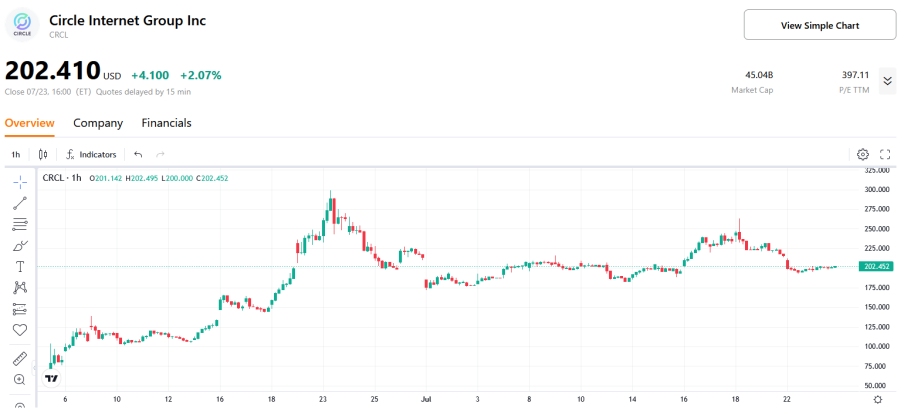Stablecoins: Overview and Their Influence on U.S. Equity and Treasury Markets


TradingKey - The U.S. government endorses stablecoins with three primary goals. First, to reinforce the dollar's dominance: as most stablecoins are tied to the dollar, they significantly bolster its global standing. Second, to increase demand for U.S. Treasuries: projections indicate that by 2028, the stablecoin market could expand eightfold, with demand for short-term Treasuries surpassing $1 trillion, substantially enhancing Treasury demand. Third, to strengthen authority in the cryptocurrency space: by adopting and regulating stablecoins, the U.S. seeks to secure a leading role in the evolving crypto landscape, safeguarding the dollar’s status as the world’s reserve currency against competing powers.
The emergence of stablecoins presents a dual impact on U.S. equities, with both bullish and bearish implications. On the bearish side, capital may shift from equities to the stablecoin market, diverting funds. On the bullish side, stablecoins are expected to drive demand for U.S. Treasuries, suppress yields, and provide a supportive backdrop for stock valuations. From a sectoral and individual stock perspective, while short-term price movements remain uncertain, sustained growth in the stablecoin market could favour compliant issuers like Circle, which benefit from transparency and are likely to attract capital over the long term. Similarly, exchanges such as Coinbase stand to gain from surging stablecoin trading volumes, potentially boosting their share prices. Conversely, traditional bank stocks may face challenges due to business displacement. However, banks that engage in stablecoin issuance—such as those planning to launch proprietary stablecoins—or invest in system upgrades to comply with regulations could unlock new avenues for growth. It is worth noting that JPMorgan has officially launched its proprietary stablecoin, JPMD. Meanwhile, Bank of America has confirmed it is actively preparing to issue its stablecoin and has entered a substantive exploration phase. These two major banks have positioned themselves as pioneers in the stablecoin sector.
The ascent of stablecoins is evolving from a peripheral factor to a pivotal force in the U.S. Treasury market. The GENIUS Act creates a structured cycle of “U.S. debt issuance — stablecoin purchases — reinvestment into Treasuries,” channelling funds back into the market. This surge in Treasury demand is poised to depress yields and elevate prices. However, stablecoins’ influence is predominantly felt in short-term Treasuries, with minimal impact on medium- and long-term bonds. This “short-term focus, long-term restraint” dynamic is likely to steepen the yield curve. From economic and policy perspectives, we hypothesise that the U.S. Treasury might recalibrate its issuance strategy—potentially increasing the share of short-term bills—to accommodate this demand, effectively pursuing a “short-term for long-term” debt replacement approach.
1. What Are Stablecoins
Stablecoins are a category of cryptocurrencies that, like Bitcoin and Ethereum, operate on blockchain technology. Their defining characteristic is price stability, achieved through a 1:1 peg to the U.S. dollar. Tether (USDT), the leading stablecoin by market capitalisation, is backed by $1 in reserves for every USDT issued. Tether’s issuance is highly lucrative, generating $13 billion in profits last year, primarily from investing reserve dollars in secure assets such as U.S. short-term Treasuries, overnight reverse repurchase agreements, and money market funds. The second-largest stablecoin, USD Coin (USDC), is issued by Circle. Remarkably, Circle’s stock price soared sevenfold within a month of its public listing.
* For related information, refer to the article published on 16 July 2025, titled “Wall Street Giants Shift Gears: JPMorgan, Citi, and Bank of America All Signal Strong Support for Stablecoins”
2. What Are the Benefits of Stablecoins? Who Uses Them?
Stablecoins excel in serving as a functional currency within the cryptocurrency space, offering greater convenience than traditional cross-border transfers, enhanced privacy, and consistent price stability. They are widely adopted in scenarios such as illicit transactions, international payments, and by individuals in regions with high inflation. The global stablecoin market now exceeds $250 billion, having expanded more than 20-fold over the past five years. Although their market capitalisation trails Bitcoin’s, their higher transaction volume underscores their utility as a medium of exchange. Nonetheless, stablecoins face risks, including associations with money laundering and vulnerability to significant fraud. Effective regulation can mitigate these concerns, making the introduction of oversight a favourable development for the stablecoin ecosystem.
3. Stablecoin Regulatory Developments
The Trump administration has advanced several cryptocurrency initiatives. In January 2025, it introduced the Strengthening U.S. Leadership in Digital Financial Technology Act. In March, it designated previously confiscated Bitcoin as part of the U.S. strategic cryptocurrency reserve. The most transformative development for stablecoins, however, is the GENIUS Act, which passed the Senate with overwhelming support on 17 June 2025. This legislation establishes a comprehensive regulatory framework for stablecoins, specifying issuer eligibility, oversight authorities, and reserve requirements (mandating over 100% backing in high-quality assets). It also addresses risk management, transparency, and anti-money laundering measures. Crypto firms must comply with stringent standards for licensing, audits, anti-money laundering protocols, cybersecurity, and reserve asset management. Although these requirements may elevate short-term operational costs, they are poised to foster long-term user confidence and regulatory trust, delivering significant benefits to compliant companies.
4. Why Is the U.S. Government Supportive of Stablecoins?
The U.S. government endorses stablecoins to achieve three primary goals: reinforcing the dollar’s global dominance, increasing demand for U.S. Treasuries, and asserting leadership in the cryptocurrency domain. Amid ongoing de-dollarisation pressures, the dollar’s peg to most stablecoins provides critical support for its international standing. Stablecoin reserves are heavily invested in short-term U.S. Treasuries, and projections by Bessent suggest that by 2028, the stablecoin market could expand eightfold, driving demand for short-term Treasuries beyond $1 trillion, significantly bolstering the Treasury market. Furthermore, as cryptocurrency demand surges and its underlying concepts evolve, the U.S. government’s strategy of embracing and regulating stablecoins aims to establish a strong presence in this emerging sector, safeguarding the dollar’s role as the global reserve currency and enhancing U.S. influence in the crypto ecosystem.
5. Stablecoins as a Form of RWA
Real-World Asset (RWA) involves transforming tangible assets into digital representations on a blockchain. Stablecoins are a prime example of RWA, effectively bridging real-world U.S. dollars to blockchain ecosystems. For instance, BlackRock has introduced BUIDL, a tokenised U.S. dollar money market fund, which has grown to $2.9 billion in size. Notably, Hong Kong and Singapore view RWA as a sector with immense growth potential, with stablecoins playing a pivotal role in its development.
6. Disruption to the Traditional Financial System
Should stablecoins maintain their rapid growth trajectory, what disruptions might they pose to the established financial system? At its core, the rise of stablecoins, coupled with the momentum of decentralisation, circumvents traditional financial intermediaries and payment companies. First, this impacts banks by eroding their profitability and diminishing their economic influence. As banks’ role in the economy weakens, the efficacy of central banks’ monetary policies is correspondingly reduced. To mitigate this, governments globally prohibit stablecoins from offering interest payments, aiming to preserve the effectiveness of monetary policy in regulating the economy.
Second, the transaction volume of stablecoins has surpassed the combined total of Visa and Mastercard. Beyond this, stablecoins are posing an increasing threat to these traditional payment giants through "efficiency substitution" and "cost substitution" effects. Specifically, they are diverting transaction shares from payment companies (particularly in cross-border payments), compressing profit margins on transaction fees, and weakening user loyalty and network dominance. This indicates that as stablecoins continue to penetrate the market, traditional payment networks will be compelled to enter a new phase of "slower profit growth and intensified competition," with their core competitive advantages—such as settlement networks and fee-pricing power—facing structural challenges.
7. Impact on U.S. Equities and Treasuries
7.1 Impact on U.S. Equities
The impact of stablecoins on U.S. equities exhibits a dual nature, with both bullish and bearish implications. On the bearish side, the primary concern is capital diversion: a thriving cryptocurrency market could draw funds away from traditional markets, redirecting capital from U.S. stocks into the digital asset ecosystem. On the bullish side, the interest rate transmission mechanism plays a key role: stablecoins have a strong demand for U.S. Treasuries, with USD-backed stablecoins currently holding over $120 billion in Treasuries, surpassing the holdings of most foreign governments. This robust demand suppresses Treasury yields, supporting stock prices. However, it’s worth noting that stablecoin demand for medium- and long-term Treasuries has not grown significantly, which somewhat limits their positive impact on equities.
The enactment of the U.S. GENIUS Act ushers stablecoins into a new era of regulatory compliance, significantly influencing U.S. equity market sectors and individual stocks. Compliant stablecoin issuers like Circle, capitalising on their transparency, have drawn substantial investor interest, evidenced by their stock prices surging dramatically post-IPO (Figure 7.1.1). Likewise, exchanges such as Coinbase have experienced robust stock price gains driven by soaring stablecoin trading volumes (Figure 7.1.2). While these stocks may face short-term consolidation or corrections following their sharp rallies, sustained rapid growth in the stablecoin market, as projected, should provide medium- to long-term support for both Circle and Coinbase. However, it should be noted that if the Federal Reserve continues to cut interest rates, short-term bond yields will decline, leading to reduced interest income for companies like Circle. This could harm the valuation of such firms. Conversely, traditional bank stocks are under pressure from business displacement, creating headwinds for the sector. However, banks that engage in stablecoin issuance—such as those planning proprietary stablecoins—or invest in system upgrades to comply with regulations may unlock new avenues for growth.
Figure 7.1.1: Circle Stock Price

Source: Refinitiv, TradingKey
Figure 7.1.2: Coinbase Stock Price
.jpg)
Source: Refinitiv, TradingKey
7.2 Impact on U.S. Treasuries
The ascent of stablecoins is transforming the global financial system, with its influence on U.S. Treasuries evolving from a marginal factor to a pivotal force. The U.S. GENIUS Act requires stablecoin issuers to hold 100% of their reserves in U.S. dollar cash or short-term Treasuries with maturities of three months or less. This regulation creates a direct linkage, establishing a cyclical system of “U.S. debt issuance — stablecoin purchases — reinvestment into Treasuries.” Should the stablecoin market grow to $2 trillion in the coming years, approximately $1.6 trillion is projected to be allocated to Treasury purchases, a volume capable of absorbing all new Treasury issuances during the Trump administration. This heightened demand is expected to depress Treasury yields and elevate their prices.
However, stablecoins predominantly influence the short end of the U.S. Treasury market, with minimal impact on medium- and long-term bonds. This “short-term focus, long-term restraint” dynamic is likely to steepen the Treasury yield curve (Figure 7.2). From economic and policy perspectives, the effects of stablecoins remain confined to specific segments, leaving the fundamental challenges in the medium- and long-term Treasury markets largely unresolved in the near term. Consequently, we anticipate that the U.S. Treasury might adapt by adjusting its issuance strategy—potentially increasing the share of short-term bills—to align with this demand, effectively pursuing a “short-term for long-term” debt replacement approach.
Figure 7.2: U.S. Treasury Yield Curve (%)
.jpg)
Source: Refinitiv, TradingKey
8. Attitudes of Countries Worldwide
Countries exhibit distinct approaches to stablecoins. Proactive adopters like Singapore, Hong Kong, and the UAE are fostering stablecoin ecosystems through pilot initiatives and supportive policies. Cautiously accommodating nations, such as the U.S., EU, and South Korea, are developing robust regulatory frameworks to balance innovation with risk mitigation. Meanwhile, restrictive jurisdictions like mainland China, Bangladesh, and Afghanistan enforce stringent controls on stablecoins, prioritising financial stability and the preservation of sovereign currency authority.
.png)






